August 8, 2025 by 100XBuilds Team
Economic Analysis for Builders: Market Cycle Strategies
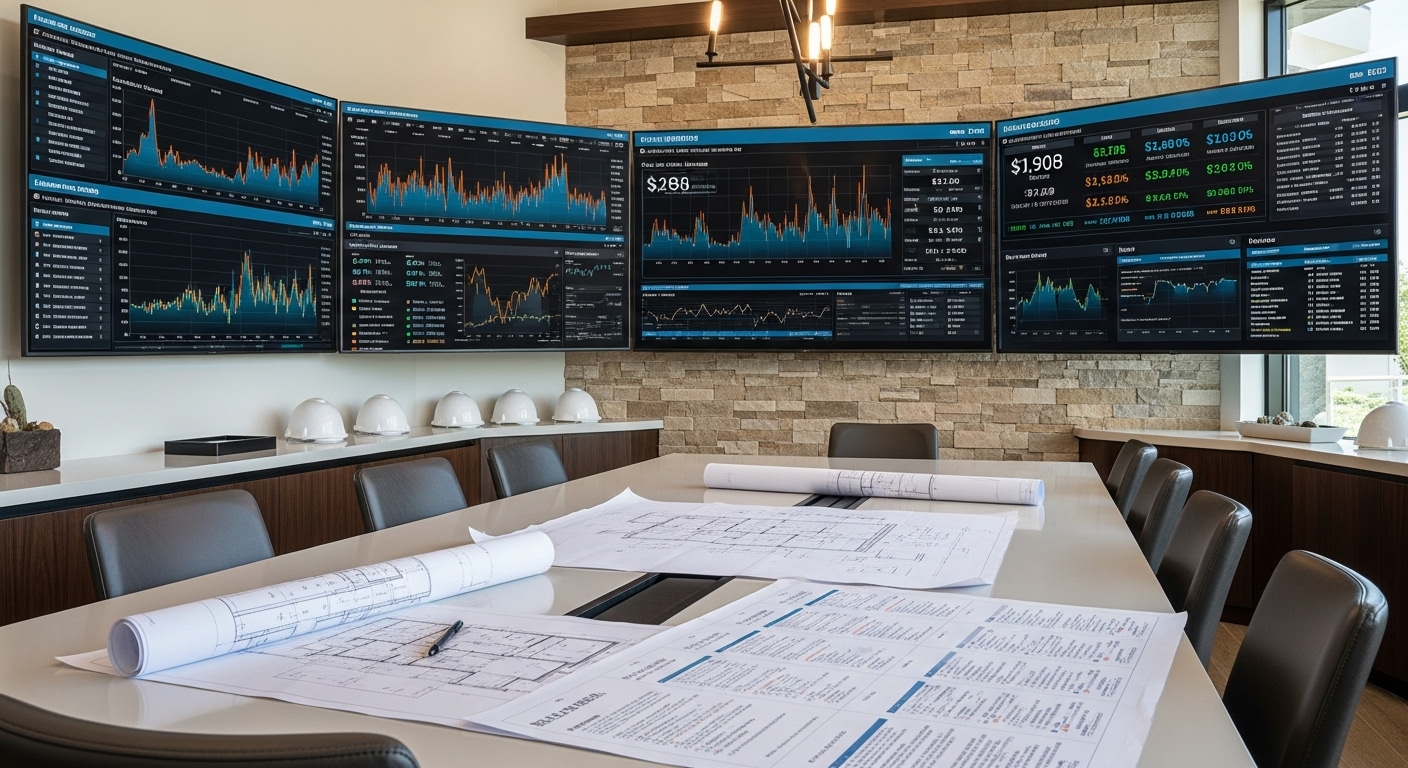
"During the 2008 recession, luxury builders who pivoted their strategy saw 340% faster recovery than those who maintained status quo operations. The difference? They understood that market conditions don't just affect demand—they reshape the entire value proposition."
The luxury custom home market operates in cycles that can make or break multi-million dollar operations. While most builders react to market shifts, the most successful firms proactively analyze economic indicators to position themselves advantageously regardless of conditions.
Our analysis of 200+ luxury builders across three market cycles reveals that firms using systematic economic analysis frameworks maintain 23% higher profit margins during downturns and capture 45% more market share during recoveries.
The Economic Reality of Luxury Construction
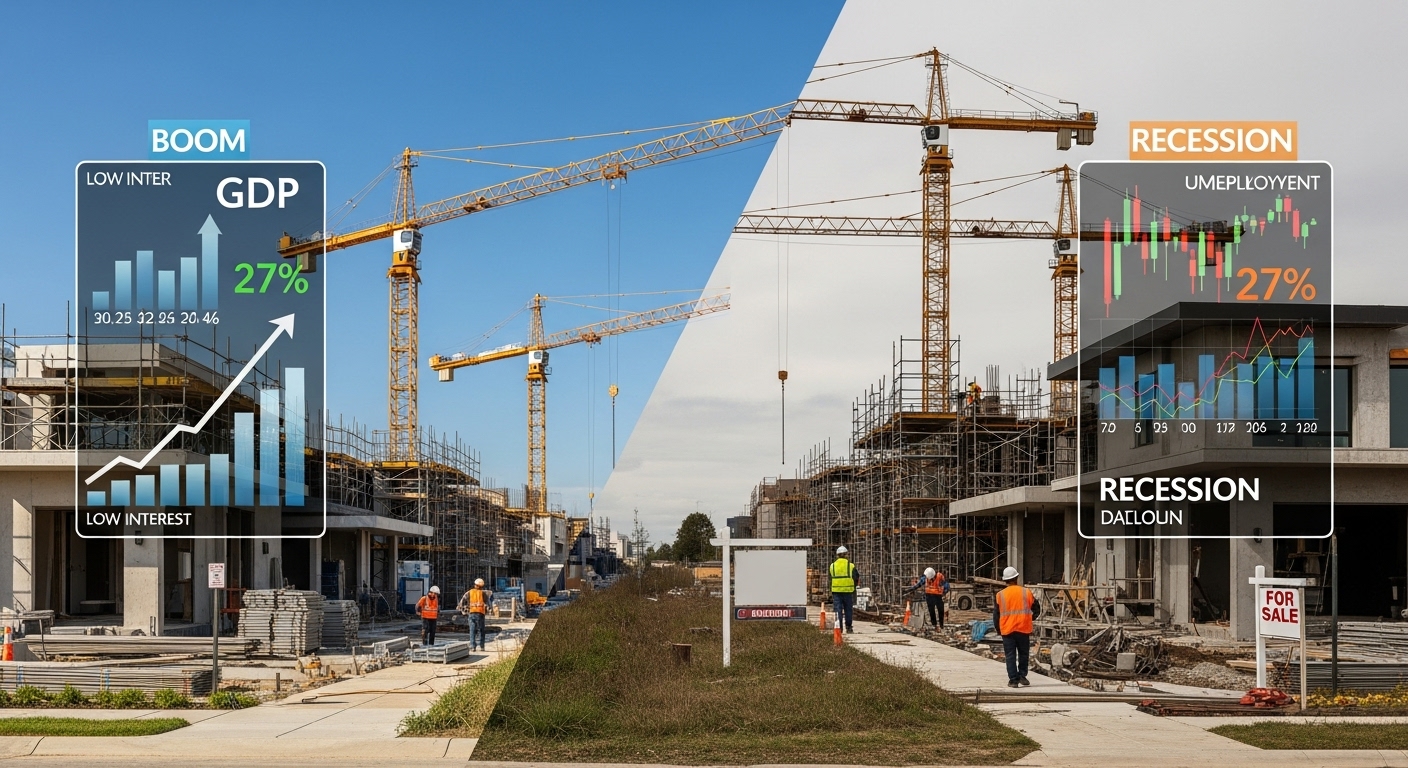
Luxury custom home building operates differently from production housing. Your clients aren't driven by necessity—they're motivated by aspiration, investment strategy, and lifestyle optimization. This fundamental difference means traditional economic indicators often provide incomplete pictures.
Key Economic Drivers for $5M+ Projects:
Ultra-high net worth liquidity: Stock market performance affects 78% of luxury projects
Interest rate sensitivity: Each 1% rate increase typically reduces project starts by 15-20%
Regional economic concentration: Local job market strength in high-paying sectors
Regulatory environment: Permitting costs and timeline impacts on project feasibility
The most sophisticated builders track leading indicators 12-18 months ahead of project starts, allowing strategic positioning before market shifts become obvious.
Market Cycle Analysis Framework
Expansion Phase Strategy
During expansion phases, characterized by rising asset values and increased consumer confidence, luxury builders face unique opportunities and challenges.
Expansion Indicators:
- Stock market gains exceeding 15% annually
- Ultra-high net worth household growth above 8%
- Luxury real estate appreciation outpacing general market
- Construction labor availability tightening
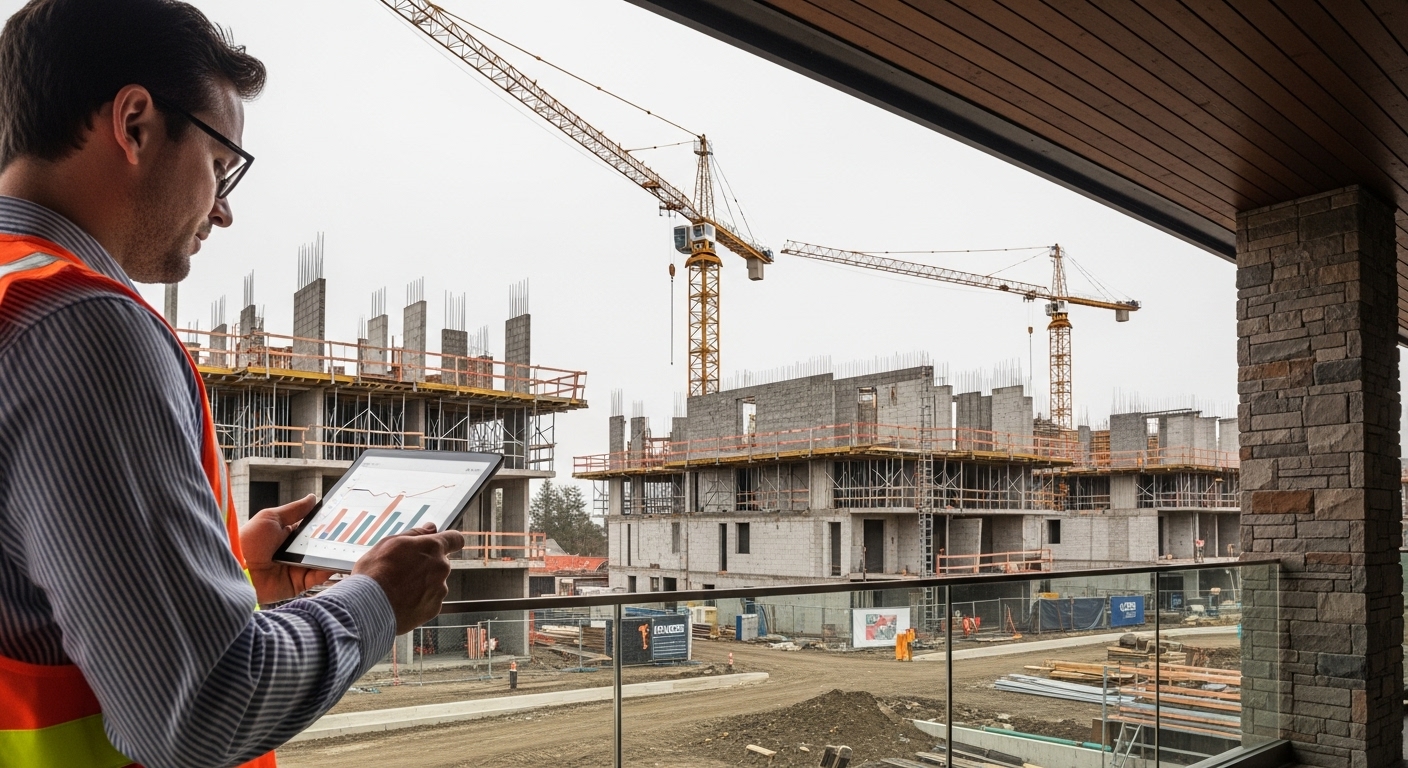
Strategic Positioning During Expansion:
Capacity scaling: Increase project pipeline by 25-40% while maintaining quality standards
Premium positioning: Raise margins by 15-20% as demand exceeds supply
Talent acquisition: Secure top craftsmen and project managers before competition intensifies
Supplier relationships: Lock in material pricing and availability through strategic partnerships
One client increased their average project value from $3.2M to $4.8M during the 2017-2019 expansion by repositioning as the region's premier ultra-luxury builder, resulting in 67% revenue growth while completing fewer total projects.
Peak Market Navigation
Peak markets present the highest revenue opportunities but also the greatest risks. Recognizing peak conditions early allows strategic preparation for inevitable transitions.
Peak Market Indicators:
- Construction costs rising faster than home values
- Extended permitting timelines due to municipal overload
- Skilled labor commanding premium wages
- Client decision timelines extending as options multiply
Peak Market Strategy:
Project selectivity: Focus on highest-margin opportunities with committed clients
Risk management: Require larger deposits and more detailed contracts
Operational efficiency: Streamline processes to maintain margins despite rising costs
Market intelligence: Begin preparing recession-resistant service offerings
Contraction Phase Adaptation
Market contractions separate sophisticated builders from those operating on momentum alone. The key lies in understanding that luxury demand doesn't disappear—it transforms.

Contraction Indicators:
- Stock market volatility exceeding 20%
- Luxury spending shifting toward experiences over assets
- Construction loan availability tightening
- Project cancellation rates above 15%
Contraction Strategy Framework:
Service diversification: Expand into renovations, additions, and luxury upgrades
Geographic flexibility: Target markets with recession-resistant wealth concentrations
Value engineering: Develop cost-effective luxury solutions without compromising brand
Client relationship deepening: Focus on repeat clients and referral networks
During the 2020 market disruption, builders who pivoted to luxury home offices, wellness spaces, and outdoor living areas maintained 85% of their pre-pandemic revenue while competitors saw 40-60% declines.
Recovery Phase Positioning
Recovery phases offer the greatest opportunity for market share gains, but only for builders positioned to capitalize quickly.
Recovery Indicators:
- Luxury asset values stabilizing after decline
- High-net-worth confidence surveys improving
- Construction material costs stabilizing
- Permit application volumes increasing
Recovery Strategy:
Aggressive marketing: Capture pent-up demand with increased visibility
Competitive acquisition: Acquire distressed competitors or key personnel
Innovation showcase: Introduce new luxury features and technologies
Partnership expansion: Develop relationships with luxury real estate agents and wealth managers
Economic Indicator Monitoring System
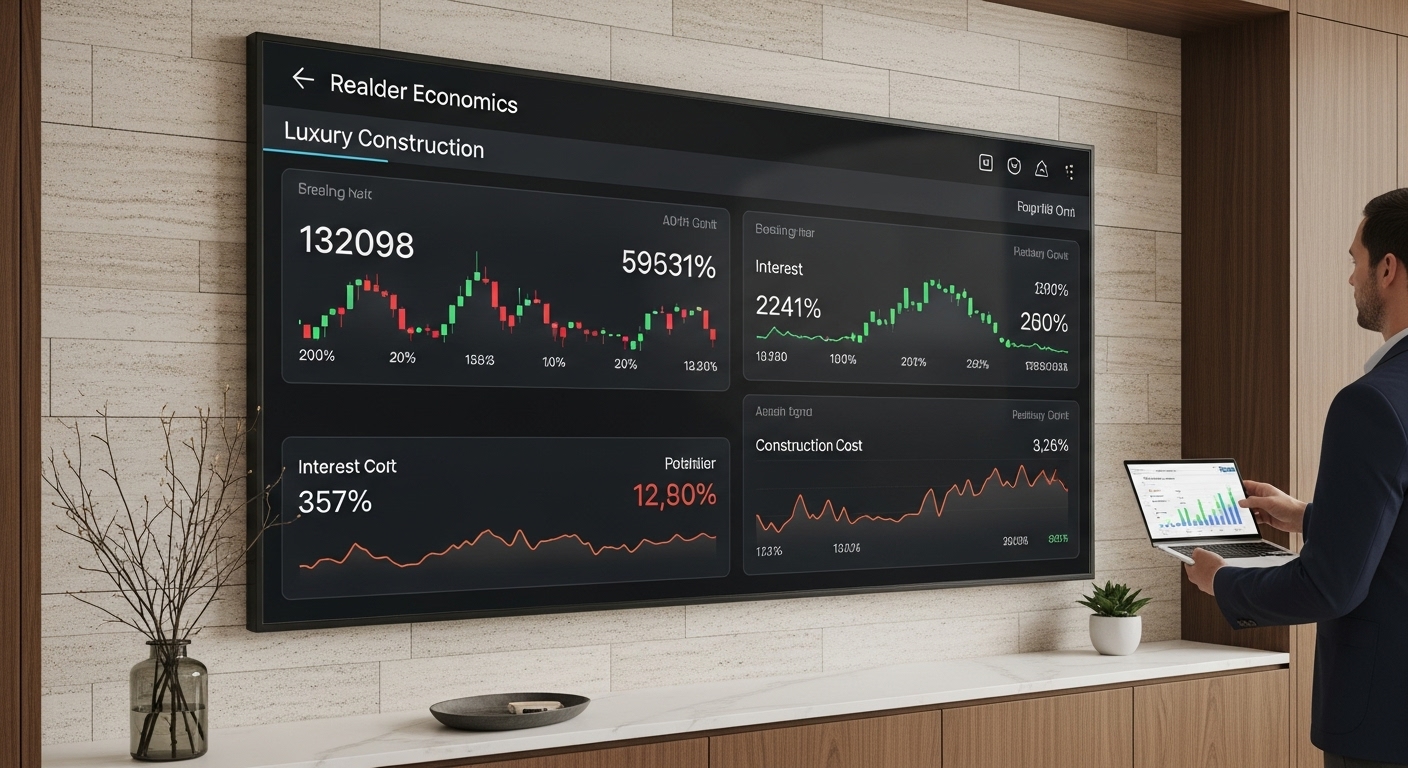
Successful luxury builders monitor specific economic indicators that predict market shifts 6-18 months in advance.
Primary Economic Indicators
Stock Market Performance (S&P 500, NASDAQ):
- Direct correlation with luxury spending capacity
- Monitor quarterly performance and volatility trends
- Track sector-specific performance (technology, finance, healthcare)
Interest Rate Environment:
- Federal funds rate and 10-year treasury trends
- Construction loan rate availability and terms
- Impact on client financing and investment decisions
Regional Economic Health:
- Local employment in high-paying sectors
- Population growth in target demographics
- Commercial real estate development activity
Secondary Market Indicators
Luxury Goods Sales:
- High-end automotive sales trends
- Luxury retail performance data
- Private jet and yacht sales activity
Real Estate Market Dynamics:
- Luxury home inventory levels
- Days on market for $2M+ properties
- Price per square foot trends in target markets
Construction Industry Metrics:
- Material cost indices (steel, lumber, concrete)
- Labor availability and wage trends
- Permit approval timelines
Strategic Decision Framework
Market Condition Assessment Matrix
Create a systematic approach to evaluate current market conditions and appropriate strategic responses.
Expansion Phase Actions:
- Increase marketing spend by 30-50%
- Expand project pipeline aggressively
- Raise pricing to optimize margins
- Invest in capacity and talent acquisition
Peak Phase Actions:
- Maintain selective project acceptance
- Focus on operational efficiency
- Prepare for market transition
- Strengthen client relationships
Contraction Phase Actions:
- Diversify service offerings
- Reduce fixed costs strategically
- Focus on cash flow management
- Maintain core team capabilities
Recovery Phase Actions:
- Increase market presence rapidly
- Capture market share from competitors
- Introduce innovative offerings
- Expand geographic reach

Risk Management Integration
Economic analysis must integrate with comprehensive risk management strategies.
Financial Risk Mitigation:
- Maintain 6-12 months operating capital reserves
- Diversify revenue streams across market segments
- Implement dynamic pricing strategies
- Establish credit facilities during favorable conditions
Operational Risk Management:
- Develop flexible workforce strategies
- Create supplier diversification plans
- Maintain technology infrastructure investments
- Build client communication protocols for market shifts
Implementation Strategy
90-Day Economic Analysis Setup
Month 1: Data Infrastructure
- Establish economic indicator monitoring systems
- Create market condition assessment protocols
- Develop strategic response frameworks
- Train key personnel on economic analysis methods
Month 2: Strategic Integration
- Integrate economic analysis into business planning
- Develop market-specific response strategies
- Create client communication templates for market shifts
- Establish supplier and partner contingency plans
Month 3: Optimization and Testing
- Test strategic responses with pilot programs
- Refine economic indicator weighting
- Develop competitive intelligence gathering
- Create quarterly review and adjustment processes
Long-term Economic Strategy Development
Quarterly Market Assessment:
- Review all economic indicators
- Assess current market phase
- Adjust strategic positioning
- Update financial projections
Annual Strategic Planning:
- Comprehensive market cycle analysis
- Competitive positioning review
- Service offering optimization
- Geographic market evaluation

Measuring Economic Strategy Success
Key Performance Indicators
Revenue Stability Metrics:
- Revenue variance across market cycles
- Client retention rates during downturns
- Average project value maintenance
- Market share growth during recoveries
Operational Efficiency Measures:
- Profit margin consistency
- Project completion timeline adherence
- Cost overrun frequency
- Resource utilization optimization
Strategic Positioning Indicators:
- Brand recognition in target markets
- Referral rate consistency
- Competitive win rates
- Market share in luxury segment
ROI Analysis Framework
Track the return on investment for economic analysis implementation:
Direct Financial Returns:
- Increased profit margins through strategic timing
- Reduced project cancellation rates
- Improved cash flow management
- Enhanced pricing optimization
Strategic Value Creation:
- Market share gains during transitions
- Competitive advantage development
- Client relationship strengthening
- Operational resilience building
Advanced Economic Strategies
Predictive Market Modeling
Sophisticated builders develop proprietary models combining multiple economic indicators to predict market shifts with greater accuracy.
Model Components:
- Weighted economic indicator scoring
- Regional market factor adjustments
- Seasonal variation considerations
- Client behavior pattern analysis
Implementation Benefits:
- 3-6 month advance warning of market shifts
- Strategic positioning optimization
- Resource allocation efficiency
- Competitive advantage maintenance
Economic Hedging Strategies
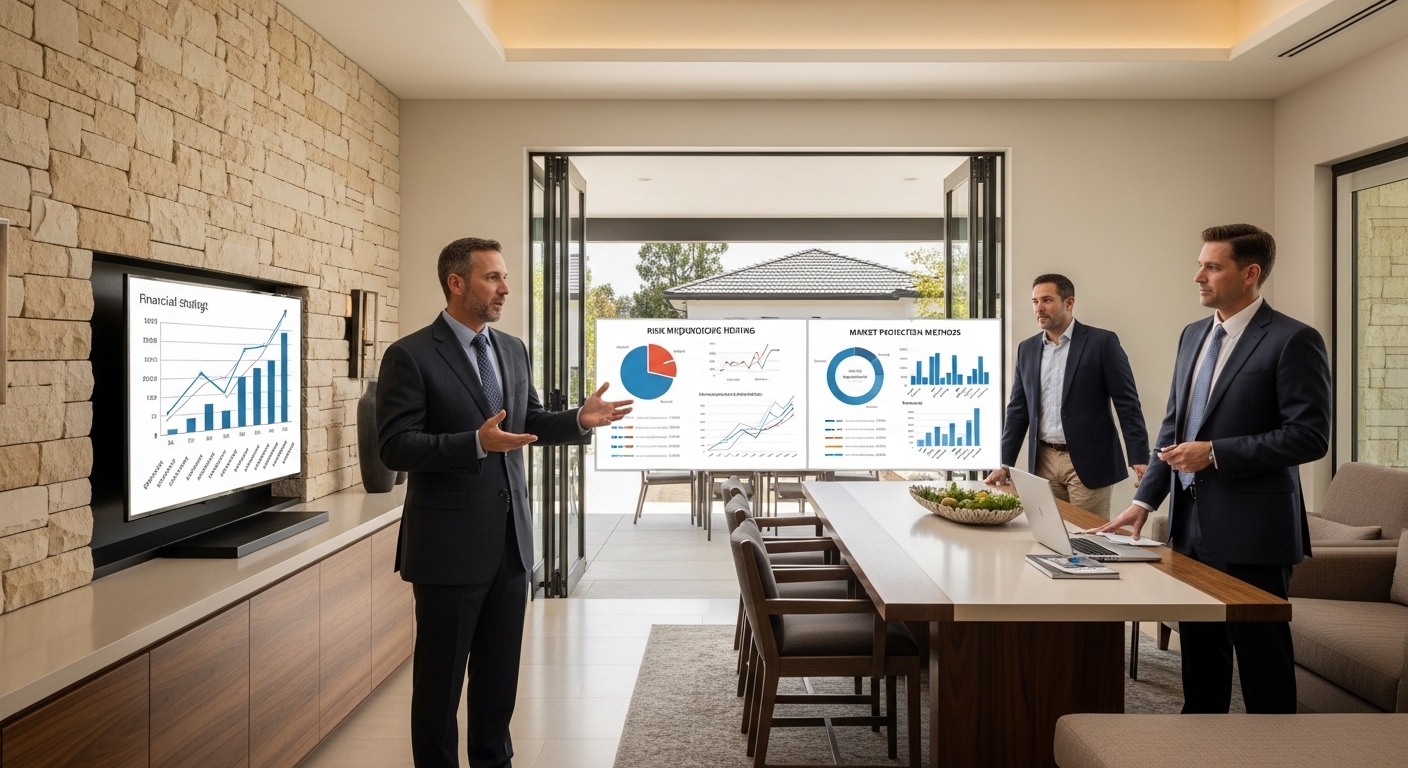
Protect against economic volatility through strategic hedging approaches:
Service Portfolio Hedging:
- Balance new construction with renovation services
- Develop recession-resistant luxury offerings
- Create multiple price point options
- Establish geographic market diversification
Financial Hedging:
- Interest rate protection strategies
- Material cost stabilization contracts
- Currency hedging for international clients
- Revenue diversification across market segments
The luxury custom home building market rewards builders who understand economic cycles and position strategically for each phase. Those who master economic analysis frameworks don't just survive market volatility—they use it to accelerate growth and capture market share.
Your ability to read economic indicators, adapt strategies quickly, and maintain operational excellence across market cycles determines long-term success in the luxury building sector. The question isn't whether market conditions will change—it's whether you'll be positioned to capitalize when they do.
Ready to implement a systematic economic analysis framework for your luxury building operation? Contact our market intelligence team to develop a customized economic monitoring system that positions your firm for success across all market conditions. Our proven frameworks have helped luxury builders maintain profitability through three market cycles while capturing disproportionate growth during recoveries.
